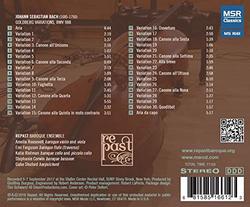| All Artists: Repast Baroque Ensemble Title: Johann Sebastian Bach: Goldberg Variations, BWV 988 - New Arrangement for Baroque Ensemble (violin & viola, flute, cello & piccolo cello, bassoon and harpsichord) | Performed on Period Instruments Members Wishing: 0 Total Copies: 0 Label: MSR Classics Release Date: 2/1/2019 Genre: Classical Style: Chamber Music Number of Discs: 1 SwapaCD Credits: 1 UPC: 681585166123 |
Search - Repast Baroque Ensemble :: Johann Sebastian Bach: Goldberg Variations, BWV 988 - New Arrangement for Baroque Ensemble (violin & viola, flute, cello & piccolo cello, bassoon and harpsichord) | Performed on Period Instruments
 | Repast Baroque Ensemble Johann Sebastian Bach: Goldberg Variations, BWV 988 - New Arrangement for Baroque Ensemble (violin & viola, flute, cello & piccolo cello, bassoon and harpsichord) | Performed on Period Instruments Genre: Classical Johann Sebastian Bach's Goldberg Variations were originally written for solo harpsichord in 1741, toward the end of Bach's life. Consisting of an aria and 30 variations, they have been re-orchestrated for many different in... more » |
Larger Image |
CD Details
Synopsis
Product Description
Johann Sebastian Bach's Goldberg Variations were originally written for solo harpsichord in 1741, toward the end of Bach's life. Consisting of an aria and 30 variations, they have been re-orchestrated for many different instrumental combinations. Why did Repast Baroque Ensemble decide to create our own new arrangement of Bach's masterpiece? Bach has always been an inspiration for us. Our first concert, 14 years ago, was a performance of the composer's Musical Offering. Since then, we have performed Bach's sonatas for violin and harpsichord and for harpsichord and viola da gamba, as well as music by his predecessors and his sons. We have also played numerous trio sonatas, including our own arrangements of his organ trios. For our performance of the Art of Fugue, which Bach wrote with unspecified instrumentation, we orchestrated the various pieces in the work. Questions of instrumentation became more pertinent in 2015 when we added a bassoon to Repast's core ensemble of violin, cello and harpsichord. Because of the limited existing repertoire for our new group of instruments, we started to create transcriptions of various pieces, sometimes augmenting our ensemble with guest musicians. Repast's audiences have always enjoyed hearing the contrast between different instrumental combinations and solo pieces, so it occurred to us: Why not arrange the Goldberg Variations? Our work on the project began in the same way it does on all of our new repertoire by singing through the score. This process helped us hear which variations sounded flute-like, or which ones seemed more like arias for the violin. In the careful listening and analysis that followed, we came up with more detailed ideas. Looking at Variation 6, we thought that a viola would allow a more expansive lower range than a violin. Variation 16 sounded orchestral, so we doubled the violin and flute lines. We learned that Variation 25 would sound quietly vulnerable if we could push the piccolo cello and the bassoon to the top of their ranges. The late Renaissance, consort-like Variation 22 needed sustained sounds from winds and strings. As we rehearsed them, certain variations sounded better when we added continuo from the harpsichord. And in a moment of spontaneity, we added a pizzicato bass line for the cello in Variation 26 to balance out the violin accompaniment. Other movements were clearly idiomatic for keyboard, so we left those alone. For the aria itself, we deliberated whether we should arrange it or not. But ultimately, the beauty of our harpsichordist's performance convinced us to keep it as a solo harpsichord piece. We hope our new arrangement of the Goldberg Variations brings light to aspects of Bach's art listeners may not yet have experienced. [Amelia Roosevelt, January 2019] Since 2004, Repast has presented a concert series in New York City that engages audiences with innovative, thematic programs of great music - both known and unknown from the Baroque period. The groups' name, Repast (meaning a meal or a feast) plays off the idea that a concert should be delicious and satisfying. The core ensemble includes violin, cello, bassoon and harpsichord, which is regularly augmented with additional musicians to enable the performance of the widest possible variety of repertoire. Repast provides numerous engrossing chamber music programs on its concert series in Brooklyn and Manhattan, as well as performances at the Miller Theatre's Bach and the Baroque series and Bargemusic. Repast has also performed at the Getty Center in Los Angeles, Miami Bach Society, Minneapolis Institute of Arts, Peak Performances in New Jersey, and other venues across the United States. The ensemble often collaborates with performing artists in other fields, including dance.
